
Do you want to help your students develop number sense? Are you overwhelmed by all the ways you could support them?
This 6 week online workshop about Number Sense Routines will prepare you to strategically pick and facilitate these short instructional routines (10-15 minutes each). You’ll help build deep and lasting number sense in your K-5 students in content areas like: Counting, Place Value, Addition, Subtraction, Multiplication, Division, and Fractions.
The 5 flexible and powerful routines you'll learn (with a 3rd Grade example of each):

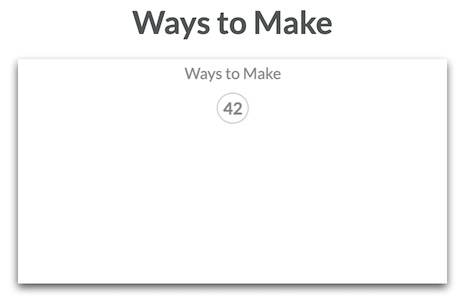
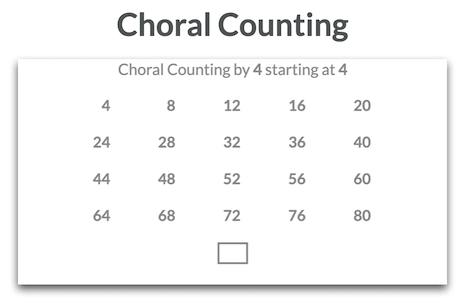

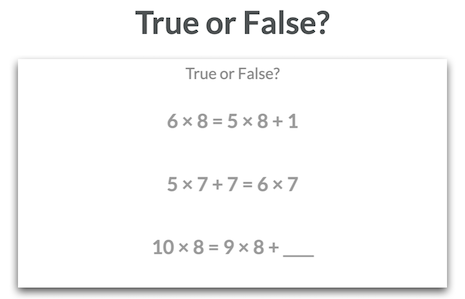
Registration Opens January 23
Enter your email address above to be reminded to register on January 23, 2026 at 8am Pacific. See all upcoming semesters here.
Days
Hours
Minutes
Seconds

Classroom Footage
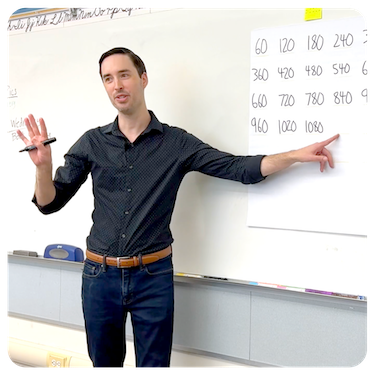
Watch all the routines in lower and upper grades classrooms.
700 Routine Slides

Ready to project or use as a reference (if you prefer chart paper or whiteboard). Plus, learn how to create your own.
Connected Routines
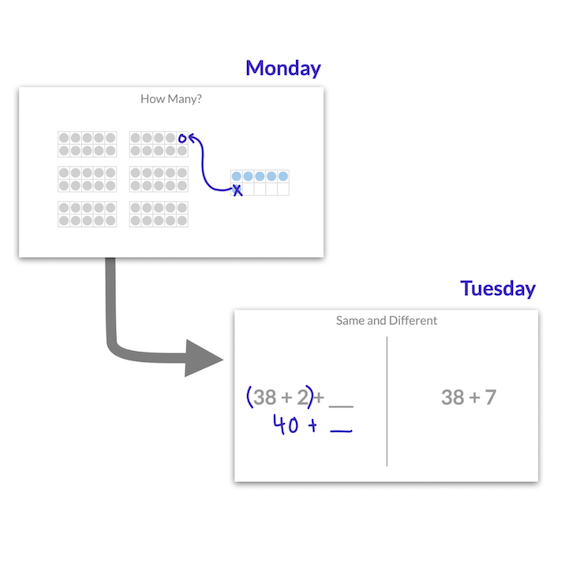
Learn how to build on student thinking using interconnected routines.

Go At Your Own Pace
All lessons are asynchronous, so you can fit your learning into your busy schedule.

Join the Discussion
Every lesson includes a message board to help you share ideas and get your questions answered (by Berkeley and other workshop participants).

Equity Deep Dive
Learn how to expand who participates and how to uncover the brilliance in every student.
Workshop Outline:
Module 1: 5 Go-To Routines and How to Facilitate Them
Lesson 1: Why and What of Number Sense Routines
Lesson 2: Routine #1: How Many? How Much?
Lesson 3: Routine #2: Ways to Make
Lesson 4: Routine #3: Choral Counting
Lesson 5: Routine #4: Same and Different
Lesson 6: Routine #5: True or False?
Lesson 7: Getting Started with Routines
Lesson 8: Full Classroom Videos [Optional]
Module 2: Place Value and Counting Routines
Lesson 1: Big Ideas of Place Value and Counting (K-5)
Lesson 2: Place Value and Counting within 20
Lesson 3: Place Value and Counting within 100
Lesson 4: Place Value and Counting within 1,000
Lesson 5: Place Value and Counting beyond 1,000
Lesson 6: Facilitation Deep Dive: How to Engage Everyone
Module 3: Addition and Subtraction Routines
Lesson 1: Big Ideas of Addition and Subtraction (K-5)
Lesson 2: Addition and Subtraction within 10
Lesson 3: Addition and Subtraction within 20
Lesson 4: Addition and Subtraction within 100
Lesson 5: Addition and Subtraction within 1,000
Lesson 6: Addition and Subtraction beyond 1,000
Lesson 7: Facilitation Deep Dive: How to Respond to Wrong Answers
Module 4: Multiplication and Division Routines
Lesson 1: Big Ideas of Multiplication and Division (K-5)
Lesson 2: Multiplication and Division within 100
Lesson 3: Multiplication and Division within 1,000
Lesson 4: Multiplication and Division beyond 1,000
Lesson 5: Facilitation Deep Dive: How to Ask Better Questions
Module 5: Fraction Routines
Lesson 1: Big Ideas of Fractions (K-5)
Lesson 2: Fractions for Grades K-2
Lesson 3: Fraction Basics, Models, and Notation
Lesson 4: Fraction Equivalence and Comparing
Lesson 5: Fraction Operations
Lesson 6: Decimals
Lesson 7: Facilitation Deep Dive: How to Annotate Student Thinking
Module 6: Advanced Facilitation and Planning Ideas
Lesson 1: Facilitation Deep Dive: How to Build Deep Connections Across Days
Lesson 2: How Many, How Much: Advanced
Lesson 3: Ways to Make: Advanced
Lesson 4: Choral Counting: Advanced
Lesson 5: Same and Different: Advanced
Lesson 6: True or False: Advanced
Lesson 7: Facilitation Deep Dive: How to Attend to and Support Equity
Lesson 8: Next Steps
Which lessons apply to you?
Select your role:
Don't see your role? Email berkeley@berkeleyeverett.com to see how the workshop might suit your needs.
What are people saying?
I am blown away by how much value I gained from this course. You truly reignited a passion for teaching math and I'm so excited to implement these routines and facilitation practices.
Gillian Brown, Teacher
This workshop was beyond fantastic! I have used Number Sense Routines before, but throughout this course I have learned how to make them even more meaningful with my questioning and annotating.
Samantha Fletcher, Teacher
I am amazed at the great conversations we have just by taking a few minutes to do these routines everyday.
I enjoyed this workshop and now understand the importance of number sense.
Casey Nash, Teacher
In the 34 years of teaching elementary students, I can truly say that this course has been one of the most powerful I have experienced.
Not only are the routines effective and engaging, they are easy to get started with.
Robin Humberstad, Interventionist
Who is Berkeley Everett?
Berkeley Everett is an elementary mathematics consultant and creator of Math Flips.
His digital resources for teachers are used across the world and he speaks internationally on topics including number sense, fluency, and sense-making.

FAQ:
How much does it cost?
$375 for regular access (16 weeks) or $450 for extended access (1 year). You can pay with credit card or with a purchase order (if your school/work is paying, for example).
How long is the workshop? When does it start?
The workshop is made up of 6 self-paced online modules. Each module takes about 2 hours to complete. The workshop content is available 3 days after registration closes (see exact dates here). The total amount of content is about 13 hours - but you’ll have 16 weeks to complete it at your own pace (or 1 year if you choose extended access).
Can I pay with a purchase order?
Yes! The process is straightforward. Here’s more information about using a purchase order.
Can I register more than one person at a time?
Yes! Here’s how to register multiple people for this workshop.
Does this workshop count towards my teaching credentials, license, or certificate?
Go to the Grassroots Workshop website and choose your state to see the answer to this question.
Can I earn graduate level professional development credits?
Yes, more information is available here.
What if I want a refund?
If you complete the workshop and don’t learn anything you can use in your own classroom (or work), email berkeley@berkeleyeverett.com within 10 business days of the end of your workshop access for a full refund.
What if I already use Number Sense Routines, will I learn something new?
Most of the content of this workshop is about how to use routines more strategically - how to sequence 4-5 days or routines to get at a big mathematical idea, how to facilitate meaningful discussions, etc. If you think you could be more strategic with how you use Number Sense Routines, you’ll likely learn something new. Here's what educator Samantha Fletcher had to say: "This workshop was beyond fantastic! I have used Number Sense Routines before, but throughout this course I have learned how to make them even more meaningful with my questioning and annotating."
Do I need a projector or tablet to do these routines with students?
No. In this workshop you'll see me use a tablet connected to a screen but you'll also see me use chart paper. You don't need anything fancy to do Number Sense Routines, just a place to write or draw (where the whole class can see and discuss).
Are the videos closed captioned?
Yes, all videos are captioned (which is especially helpful when listening to student explanations in the classroom videos).
I still have questions...
Email your questions to berkeley@berkeleyeverett.com
If you're a:
Coach / Interventionist / Leader
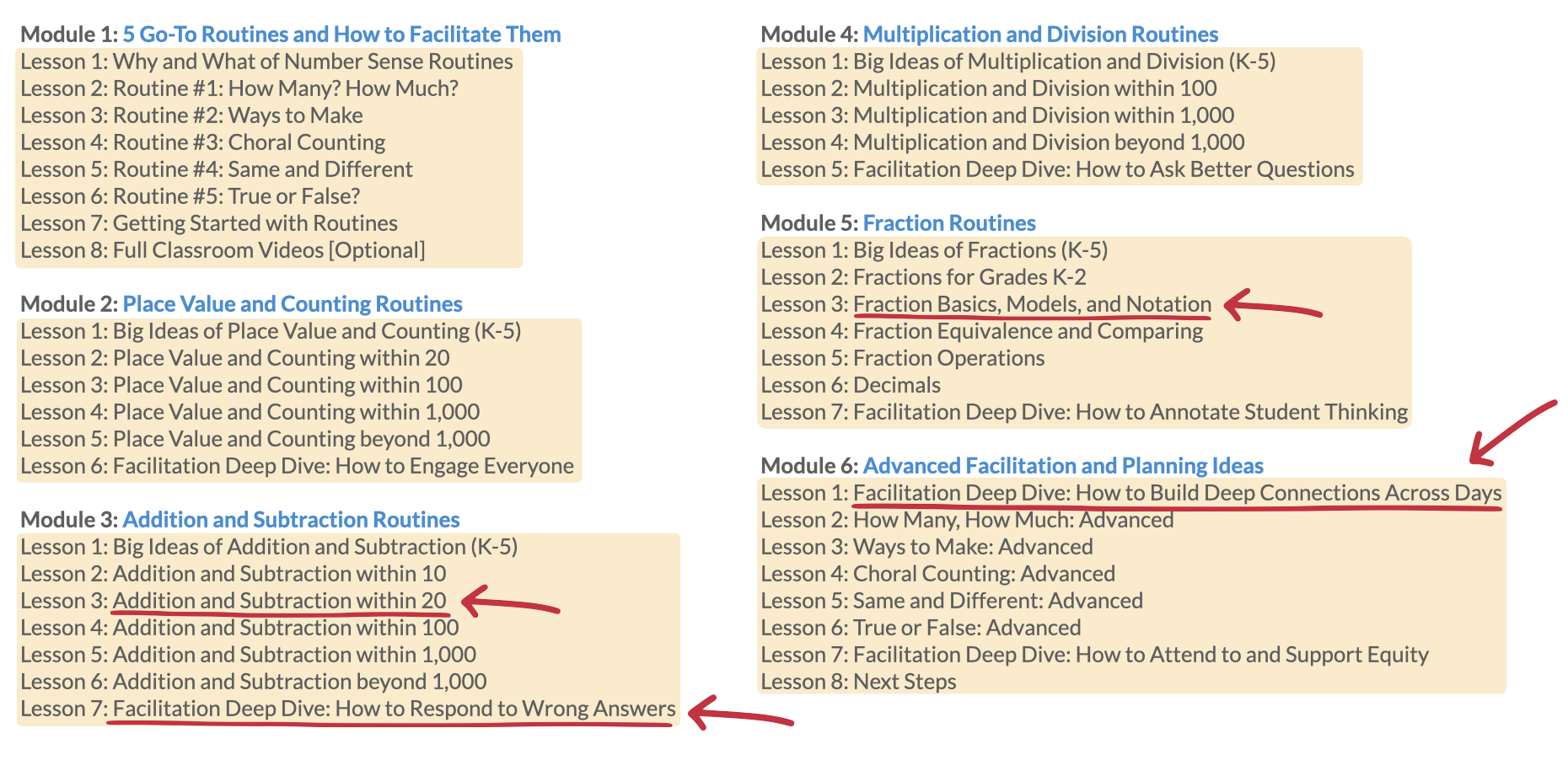
Yellow highlights show lessons applying to Coaches/Interventionist/Leaders.
Your favorite content lessons might be: "Addition and Subtraction within 20" and "Fraction Basics, Models, and Notation" since these content areas are often challenging the most challenging to teach in elementary school. You'll learn new ways to approach these topics with teachers and their students.
Your favorite facilitation lessons might be: "How to Respond to Wrong Answers" since we can't change the culture of math class without changing how we react to student ideas (especially "wrong" ideas) OR "How to Build Deep Connections Across Days" since the power of routines comes from how they build on one another.
Plus: Classroom video footage comes from both a 1st/2nd Grade combo class and a 4th Grade class so you'll see the routines and facilitation in both lower grades and upper grades.
If you're a:
Kindergarten Teacher
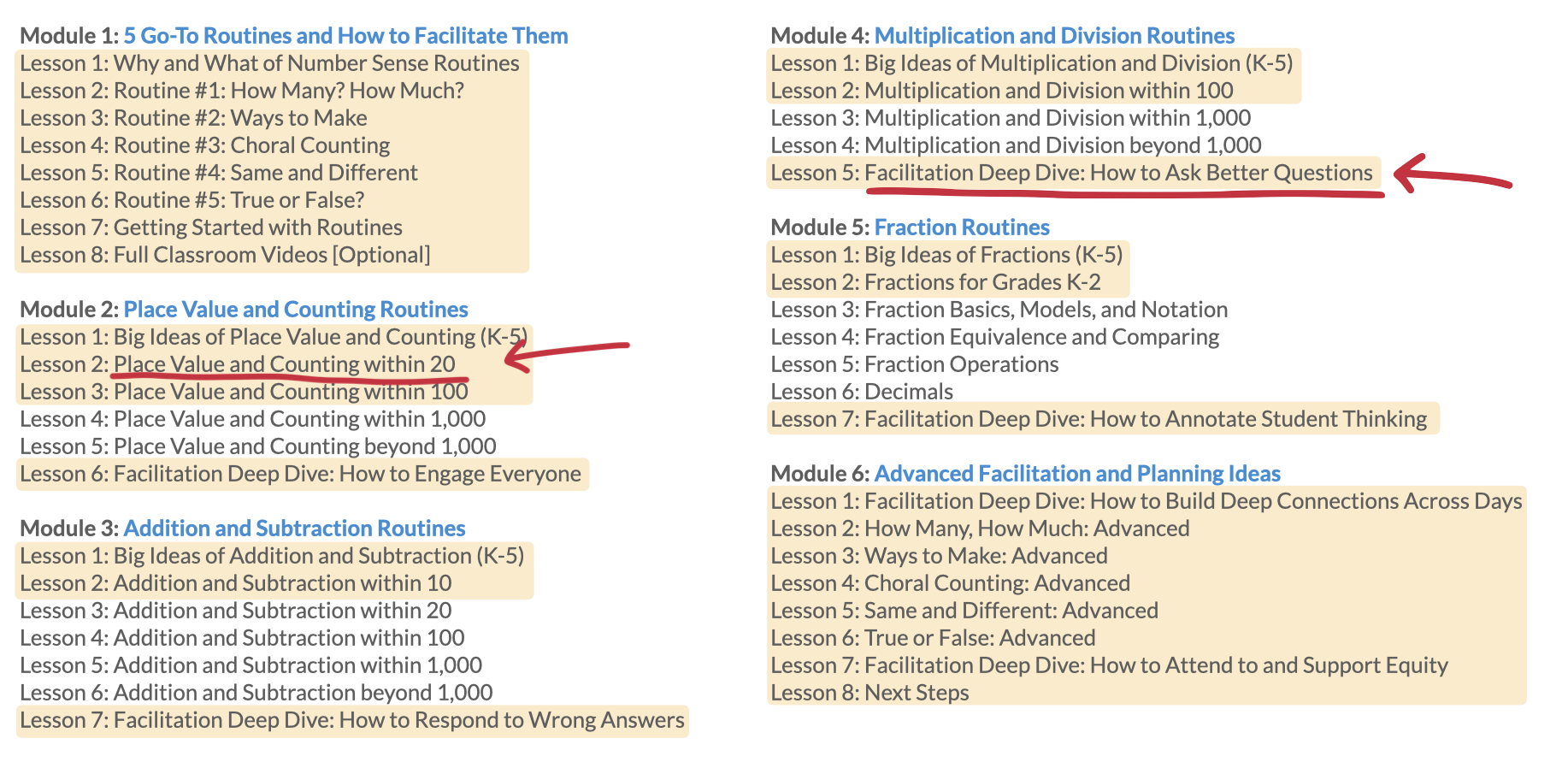
Yellow highlights show lessons applying to Kindergarten.
Your favorite content lesson might be: "Place Value and Counting within 20" since the numbers 11-19 are so difficult to help students understand. We'll dig into how to illuminate place value and counting ideas using lots of visuals and open-ended prompts.
Your favorite facilitation lesson might be: "How to Ask Better Questions" since it can be hard to think of other ways to ask about content that feels so "basic" (but isn't!). Kindergarteners come with big personalities and deserve big questions to match.
Plus: Classroom video footage features a 1st/2nd Grade combo class (and a 4th Grade class) so you'll see the routines and facilitation with students similar to your grade level (you'll even some wiggles when students are on the carpet and how we can approach engagement in those moments).
If you're a:
1st Grade Teacher
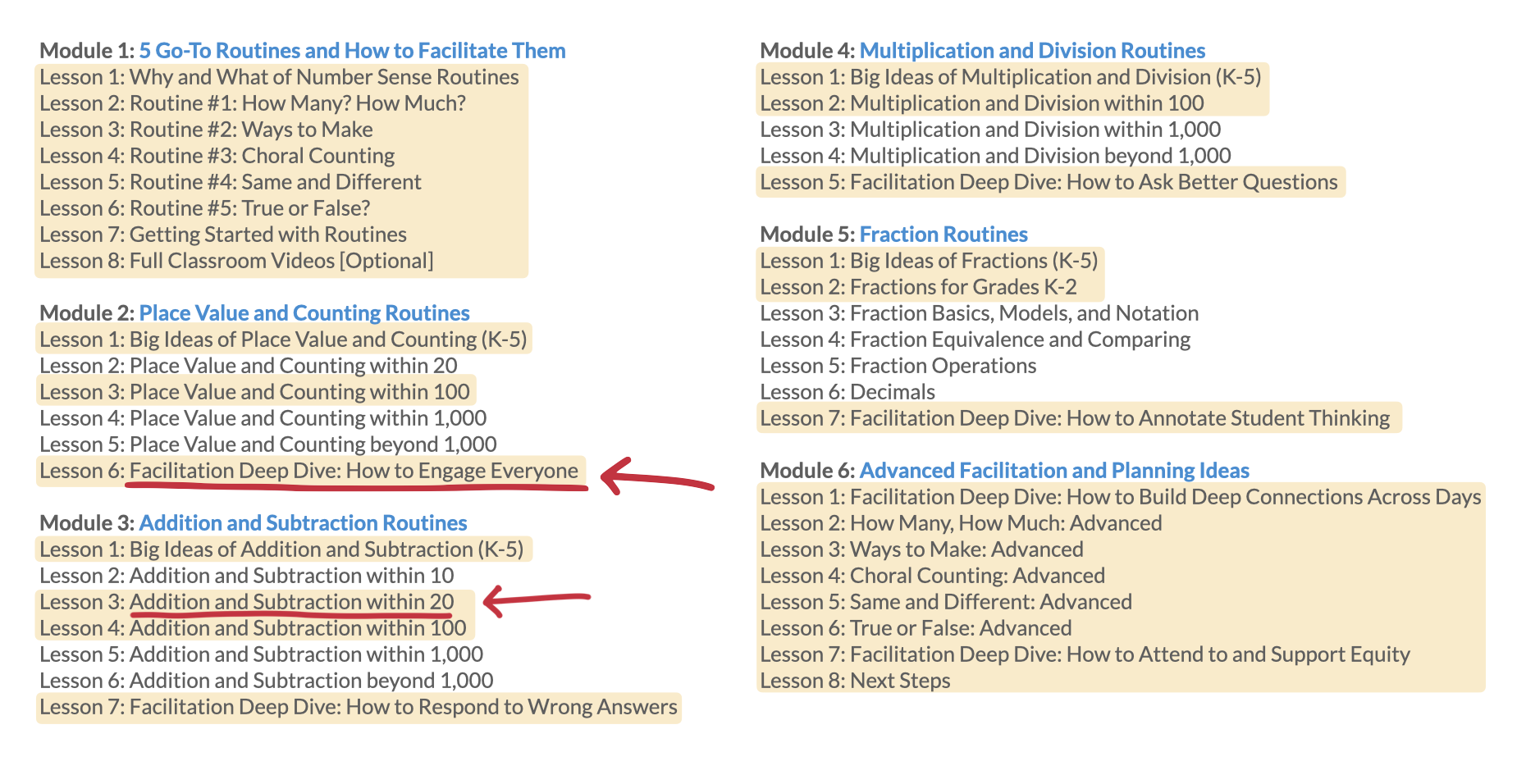
Yellow highlights show lessons applying to 1st Grade.
Your favorite content lesson might be: "Addition and Subtraction within 20" since this often divides a class between the kids who get it and the kids who don't get it YET. How do we support and challenge everyone with this topic?
Your favorite facilitation lesson might be: "How to Engage Everyone" since 1st graders are open to new ideas if they are engaged. AND, we know how challenging it is to sustain that engagement for 10-15 minutes of whole-group discussion.
Plus: Classroom video footage features a 1st/2nd Grade combo class (and a 4th Grade class) so you'll see the routines and facilitation with students at the grade level you teach.
If you're a:
2nd Grade Teacher
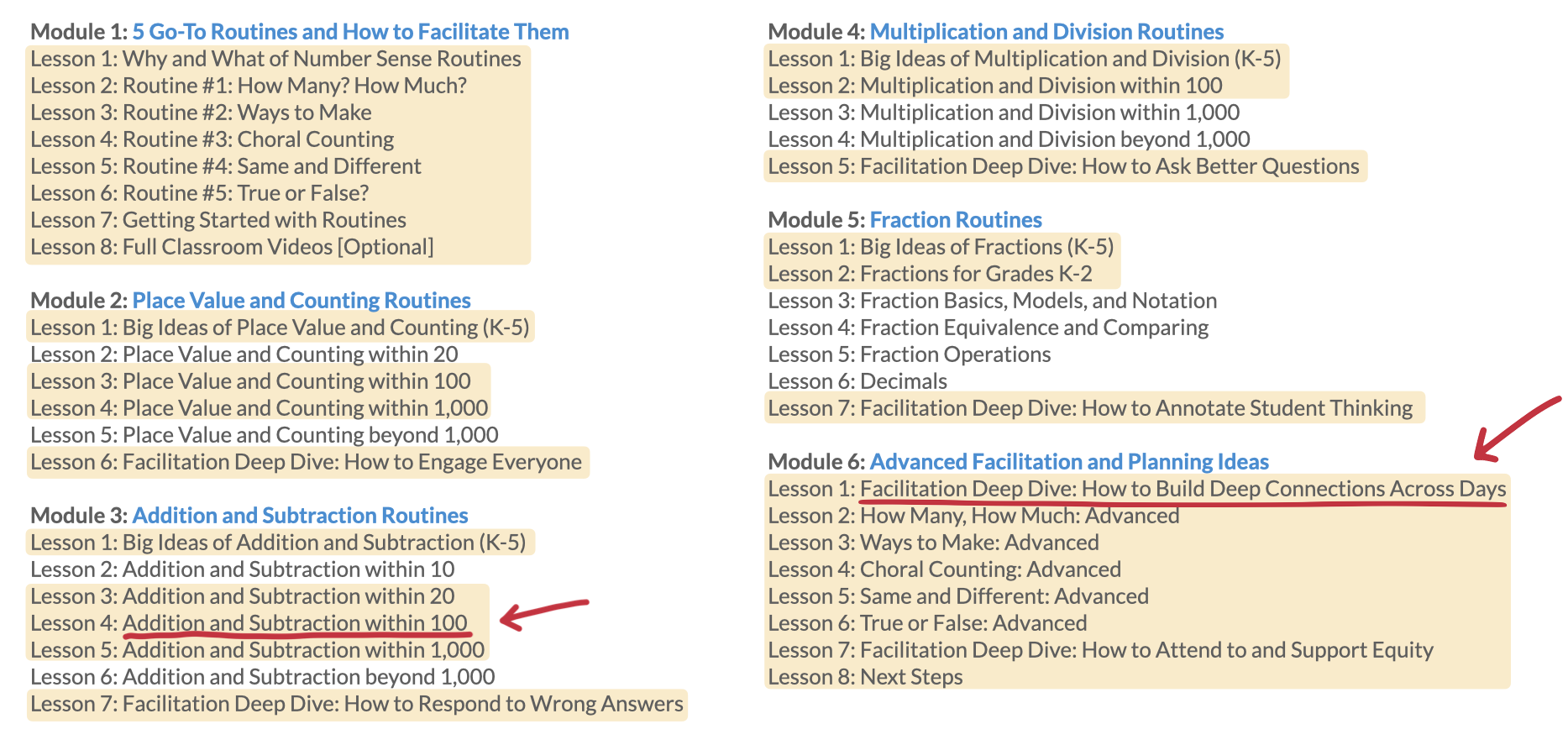
Yellow highlights show lessons applying to 2nd Grade.
Your favorite content lesson might be: "Addition and Subtraction within 100" since this is where Addition and Subtraction get too abstract for students if they aren't using their number sense. We can make this topic approachable and differentiated.
Your favorite facilitation lesson might be: "How to Build Deep Connections Across Days" since the power of routines comes from how they build on one another. You'll learn how to string them together to get big "a-ha!" moments from your 2nd graders.
Plus: Classroom video footage features a 1st/2nd Grade combo class (and a 4th Grade class), so you'll see the routines and facilitation with students at the grade level you teach.
If you're a:
3rd Grade Teacher
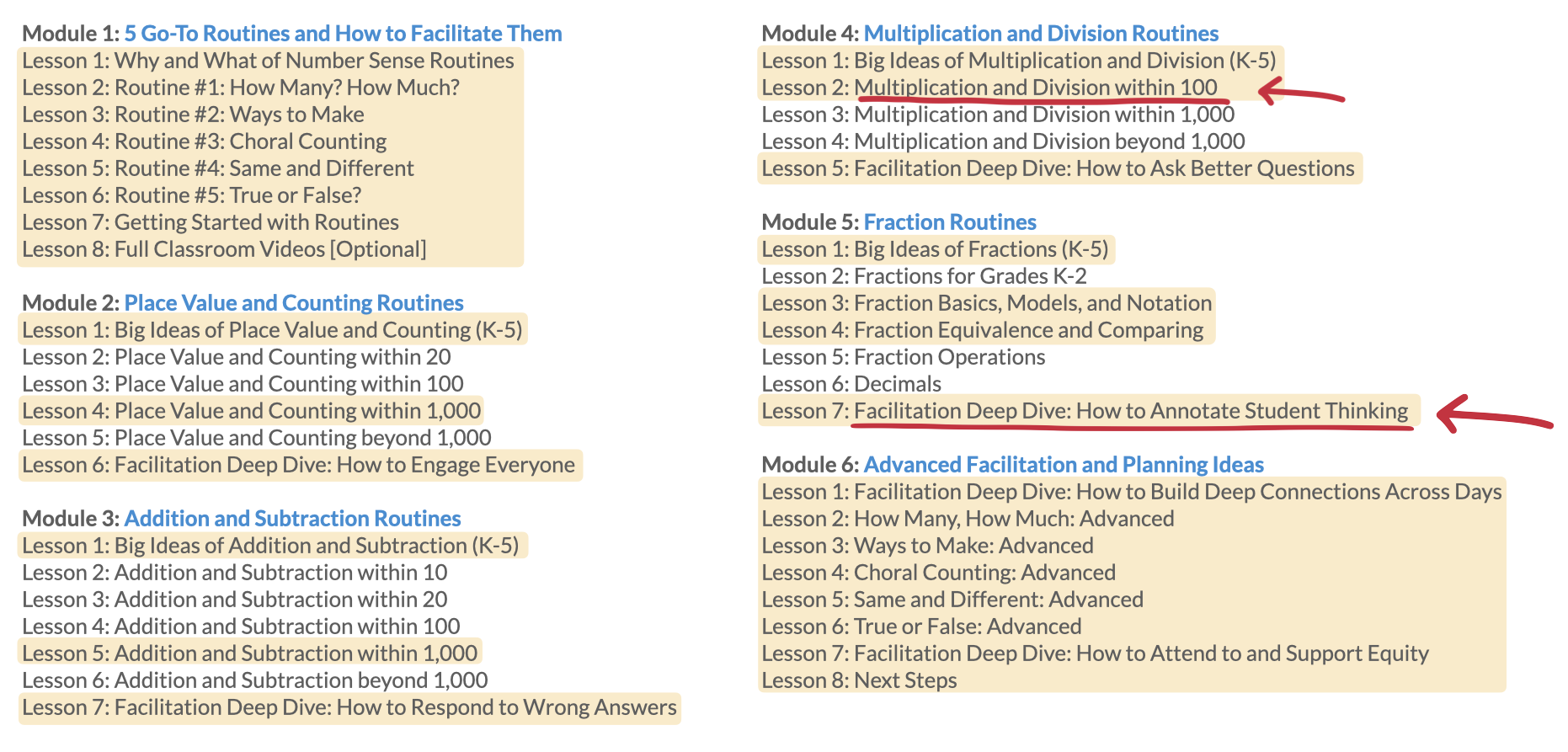
Yellow highlights show lessons applying to 3rd Grade.
Your favorite content lesson might be: "Multiplication and Division within 100" since this is what is new and challenging about 3rd grade (along with Fractions - so you might also love the "Fractions Basics, Models, and Notation" lesson). You'll have new ways to support students with multiplication and division through visuals, pattern finding, and equation flexibility.
Your favorite facilitation lesson might be: "How to Annotate Student Thinking" since a lot of the math in 3rd grade is abstract and skillful teacher annotation can make the difference between a bunch of blank stares and a room full of "lightbulb moments."
Plus: Classroom video footage features a 4th Grade class (and a 1st/2nd Grade combo class ) so you'll see the routines and facilitation with students similar to your grade level.
If you're a:
4th Grade Teacher
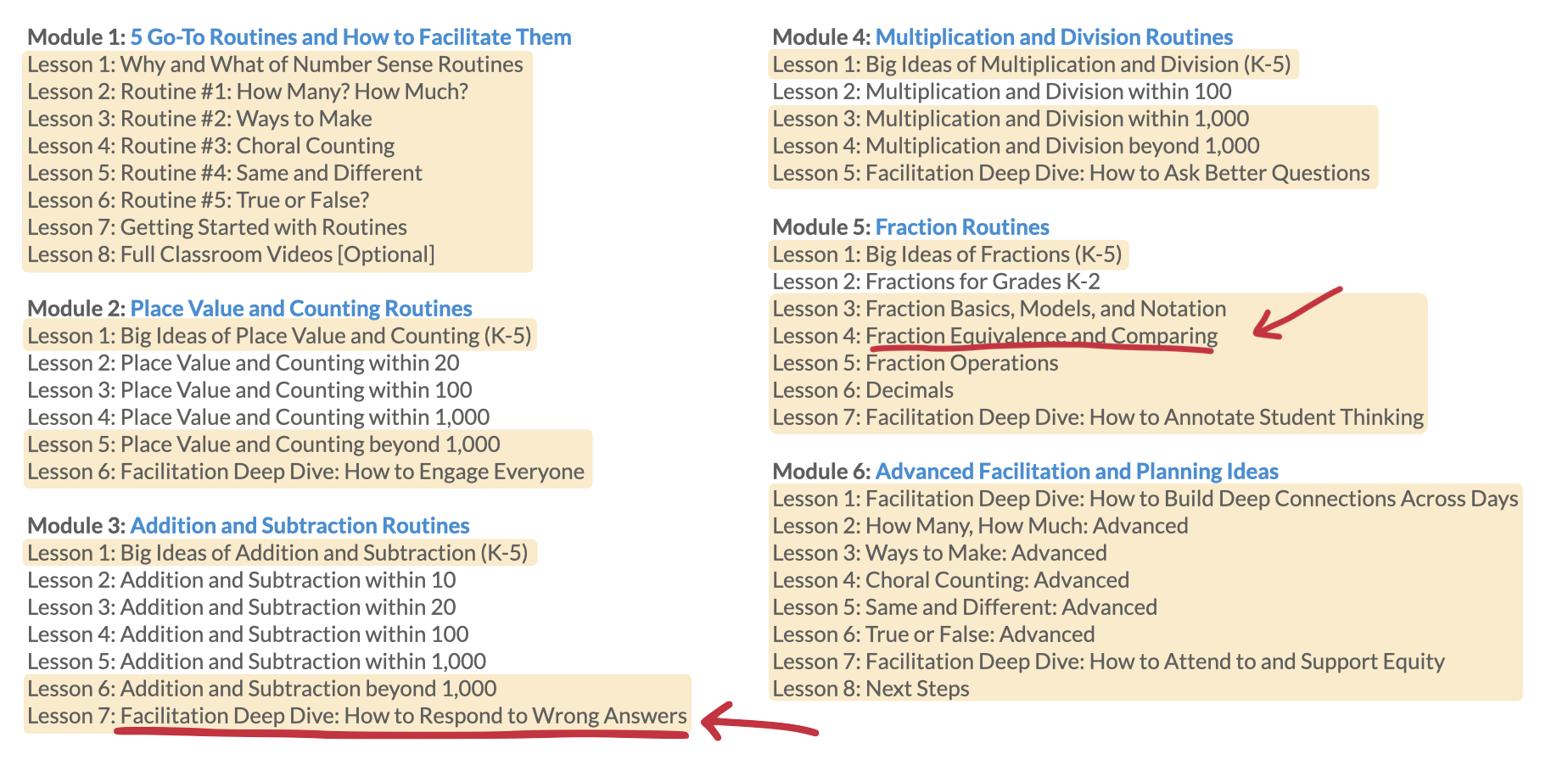
Yellow highlights show lessons applying to 4th Grade.
Your favorite content lesson might be: "Fraction Equivalence and Comparing" since this is a difficult topic for students to understand. We can engage students' number sense in ways that unlock fraction understandings so they can get the right answer AND know why it worked (and how to explain it).
Your favorite facilitation lesson might be: "How to Respond to Wrong Answers" since 4th grade is when many students start to shut down in math class. We can undo any math anxiety by showing students we value their thinking (not just right answers).
Plus: Classroom video footage features a 4th Grade class (and a 1st/2nd Grade combo class ) so you'll see the routines and facilitation with the grade you teach!
If you're a:
5th Grade Teacher
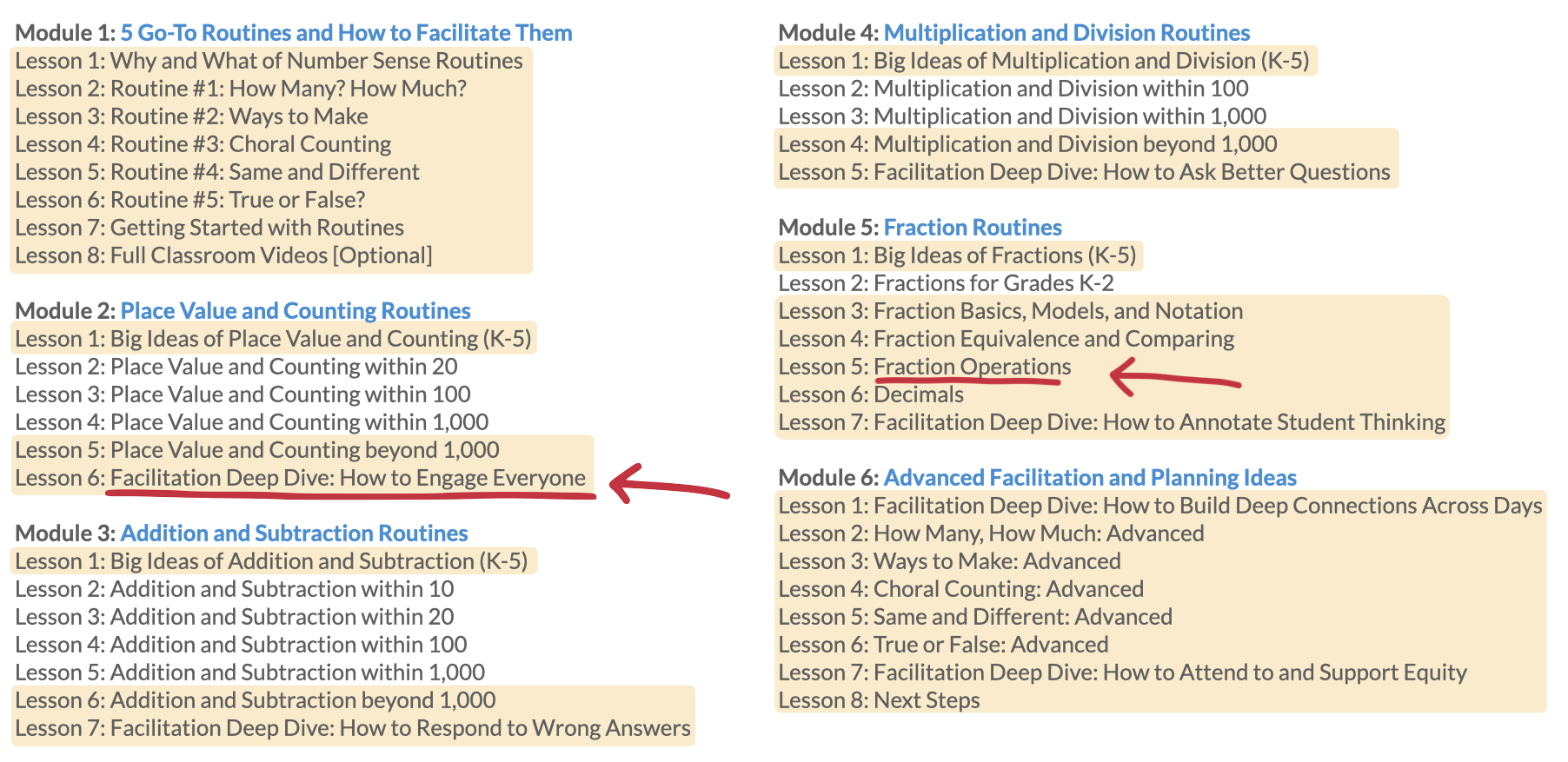
Yellow highlights show lessons applying to 5th Grade.
Your favorite content lesson might be: "Fraction Operations" since this is a topic where students often stick with tricks (without understanding why they work) instead of using their intuitive number sense. We can better prepare them for math in 6th-12th grade with a toolkit for visualizing and manipulating fraction operations.
Your favorite facilitation lesson might be: "How to Engage Everyone" since many 5th graders prefer not to share in whole-group discussions. With a few different techniques we can get everyone thinking and sharing - which changes the way a classroom feels during a math lesson.
Plus: Classroom video footage features a 4th Grade class (and a 1st/2nd Grade combo class ) so you'll see the routines and facilitation with students similar to your grade level.
If you're a:
Multiple-Grades Teacher

Yellow highlights show lessons applying to Multiple-Grades Teachers.
Your favorite content lessons might be: "Addition and Subtraction within 20" or "Fraction Basics, Models, and Notation" since these are foundational content areas for lower and upper grades. More exciting, though, is how these routines allow you to engage students at multiple grade levels at once - in many cases the routines are already differentiated!
Your favorite facilitation lessons might be: "How to Respond to Wrong Answers" since students will open up once they realize math is more about ideas than fast and correct answers. You might also like "How to Build Deep Connections Across Days" since the power of routines comes from how they build on one another.
Plus: Classroom video footage features a 1st/2nd Grade combo class and a 4th Grade class so you'll see how the routines work across grade levels and within a multi-year combo class.
